
KINGSLEY HOLGATE'S AFRIKA ODYSSEY EXPEDITION


Once again, the expedition Defender D300s are put through their paces as they tackle narrow, winding, switchback roads that take us through Rwanda’s land of a thousand hills. One moment, we’re winding through rural landscapes of rolling tea plantations and steeply terraced hills growing every crop imaginable; the next, a dense tangle of gigantic trees looms ahead, the road clinging improbably to steep, forested slopes that tumble like huge green waves towards the distant Burundi border. We are heading to Nyungwe National Park.
The excitement grows as we get a message from Nyungwe park manager Protais Niyigaba saying that the calabash ceremony to collect symbolic water from all 22 African Parks-managed areas across the continent will, in the case of Nyungwe, take place at a small spring deep in the rainforest. With today’s modern mapping, this tiny rivulet has been proven to be the furthest and highest source of Africa’s longest river – the Nile.
Renowned African explorer Kingsley Holgate and his expedition team from the Kingsley Holgate Foundation recently set off on the Afrika Odyssey expedition – an 18-month journey through 12 African countries to connect 22 national parks managed by African Parks. The expedition’s journey of purpose is to raise awareness about conservation, highlight the importance of national parks and the work done by African Parks, and provide support to local communities. Follow the journey: see stories and more info from the Afrika Odyssey expedition here.

The source of the White Nile was, for centuries, one of the world’s great unsolved mysteries, and we’ve given a chunk of our lives to exploring this historic river, much of it in inflatable boats. We’ve been to the Blue Nile’s source in Ethiopia’s Highlands and the southernmost source of the White Nile in Burundi. We’ve stood at the Speke monument, marking the Lake Victoria source of the Nile and, with good friend Jon Dahl of Nile River Explorers, rafted the rapids below the Bujagali Falls. We’ve stood in awe on the lip of the Murchison Falls near Lake Albert and reached Omdurman in the Republic of Sudan, where the Blue and White Niles meet. We’ve tracked the mighty river’s meandering course past the pyramids, temples and tombs of Sudan and Egypt to reach the two mouths of Damietta and Rosetta on the Mediterranean coast, where the famous Rosetta Stone that unravelled the mysteries of ancient Egyptian hieroglyphics was discovered in 1799. As part of this Afrika Odyssey expedition, finally reaching the furthest and highest source of the White Nile in Nyungwe is an important milestone.
An old forester’s cottage becomes our base camp at the Uwinka visitors centre in the heart of Nyungwe National Park. The African Parks management team is, as always, their smiling, welcoming selves. Protais gives us a colourful background to the impressive conservation and community work that the African Parks team, with the Rwanda Development Board and other partners, has been achieving since the partnership was formed three years ago.
But it seems we’ve got a bit of work to do before getting to the source of the Nile. “You’re going to acclimatise a bit first,” says Protais with a cheeky grin. “Some hill walking to understand the forests better and what’s in them, together with some community interactions and then on the last day, we’ll take you to the Nile’s source.”

Nyungwe National Park turns out to be one of Rwanda’s best-kept secrets – included in Africa Geographic’s ultimate primate safari. Tucked into the southwest corner and with misty views over beautiful Lake Kivu to the Virunga volcanoes in the north, it’s one of the oldest rainforests left in Africa, covering 1,000km² of dense Afromontane forests, interspersed with bamboo-covered slopes, sun-dappled grasslands, tumbling mountain streams and wetlands. Nyungwe, in a word, is magnificent. The forest takes on a liberating primal presence even before you’ve got your walking shoes on.

Booted up, carrying rain jackets and armed with sturdy hiking sticks, our too-many-weeks-in-Landies fitness levels are put to the test as senior ranger-guide Claver Ntoyinkima leads us on the first trail – destination, the Ndambarare waterfall. “It’s just a short walk, about seven kilometres there and back,” Claver says impishly. For him, it’s literally a walk in the park, but what he doesn’t mention is the high altitude and that, at times, the trail becomes a near-vertical drop as it twists and turns down steep, thickly forested slopes, putting dodgy knees and creaky muscles to the test. Even super-fit Ross is out of breath by the time we reach the waterfall’s base. It’s spectacularly beautiful and well worth the effort, and we gather water-smoothed pebbles to join the growing pile that will be used to build the end-of-expedition ceremonial isivivane (pile of stones) in a few months. Gazing up into the forest heights above, Kambogo Ildephonse, Nyungwe’s energetic commercial development manager, says cheerfully, “In Rwanda, we have a saying: what goes down must come up! But, we’ll take it easy.”
Both Claver and Kambogo are veritable mines of information. As we puff and pant back up the trail, its clear they love their forest home. They tell us that Nyungwe is the watershed for Africa’s two largest rivers, the Congo and the Nile, providing significant portions of Rwanda’s fresh water. It contains over 1,100 recorded plant species – a single, giant tree can be home to a host of other plants, and exquisite flowering orchids found nowhere else are endemic here – and 85 mammal species, including 13 of Africa’s primates. Some notable primates include the eastern chimpanzee, Ruwenzori black-and-white colobus, silver, owl-Faced, golden, mona and L’Hoest’s monkeys.

Wiping the condensation from his glasses, Kambogo also tells us that the scientific world is abuzz with the recent discovery of the critically endangered Hills Horseshoe Bat in these forests and that Nyungwe has just been added to the UNESCO World Heritage List, Rwanda’s first site to get this coveted status.
Claver stops to identify every bird call – he’s not called the ‘Bird Man of Nyungwe’ for nothing. There are over 350 bird species in these forests, and Nyungwe is one of Africa’s most important sites for bird conservation. Claver also talks about the positive change since African Parks came on board, the development of more trails and growing tourism, stronger community involvement, and former poachers now helping to conserve the forests by becoming eco-rangers and removing hundreds of snares from the forest. “So much improvement in just three years!” he laughs as a crack of thunder booms overhead.

Claver quickly climbs into his waterproof gear – trousers, poncho, hood and gumboots, looking more like a salmon fisherman. The rest of us get drenched; the deluge is icy cold, our rain jackets are no match, and we’re soaked to the skin in minutes. “It’s not called a rainforest for nothing,” grumbles Kingsley, looking like a water-logged forest troglodyte, slowly putting one muddy size 14 boot in front of the other as we trek soggily back through the dripping trees to the Defenders.
With wet boots, socks and clothes steaming next to the fire in our cosy basecamp cottage, we wolf down plates of Ross’s chicken curry. At last light, the clouds lift to reveal the endless forested hills that make up the eastern escarpment of Africa’s Great Rift Valley and beyond, Lake Kivu shining silver as the stars come out.
 DID YOU KNOW that African Parks offers safari lodges and campsites where 100% of tourism revenue goes to conservation and local communities? You can plan and book your African Parks safari to Nyungwe National Park and other parks by clicking here.
DID YOU KNOW that African Parks offers safari lodges and campsites where 100% of tourism revenue goes to conservation and local communities? You can plan and book your African Parks safari to Nyungwe National Park and other parks by clicking here.
It’s early to bed – we’re up at 4am the next morning for chimp and colobus trekking and get to see both, first, in the Cyamudongo forest and then later, more chimps of the 70-strong Mayebe community in the shadow of Mt Bigugu, the highest peak in the park, making it a truly ultimate primate safari.

In a valley close to the Nyungwe River, Claver brings us close to a troop of at least 50 Ruwenzori black-and-white colobus monkeys, high up in the canopies and feeding on fresh leaves. Leaping from tree to tree, they truly are the acrobats of Nyungwe, and we learn that this group is part of the largest known colobus troop in the world – more than 500.
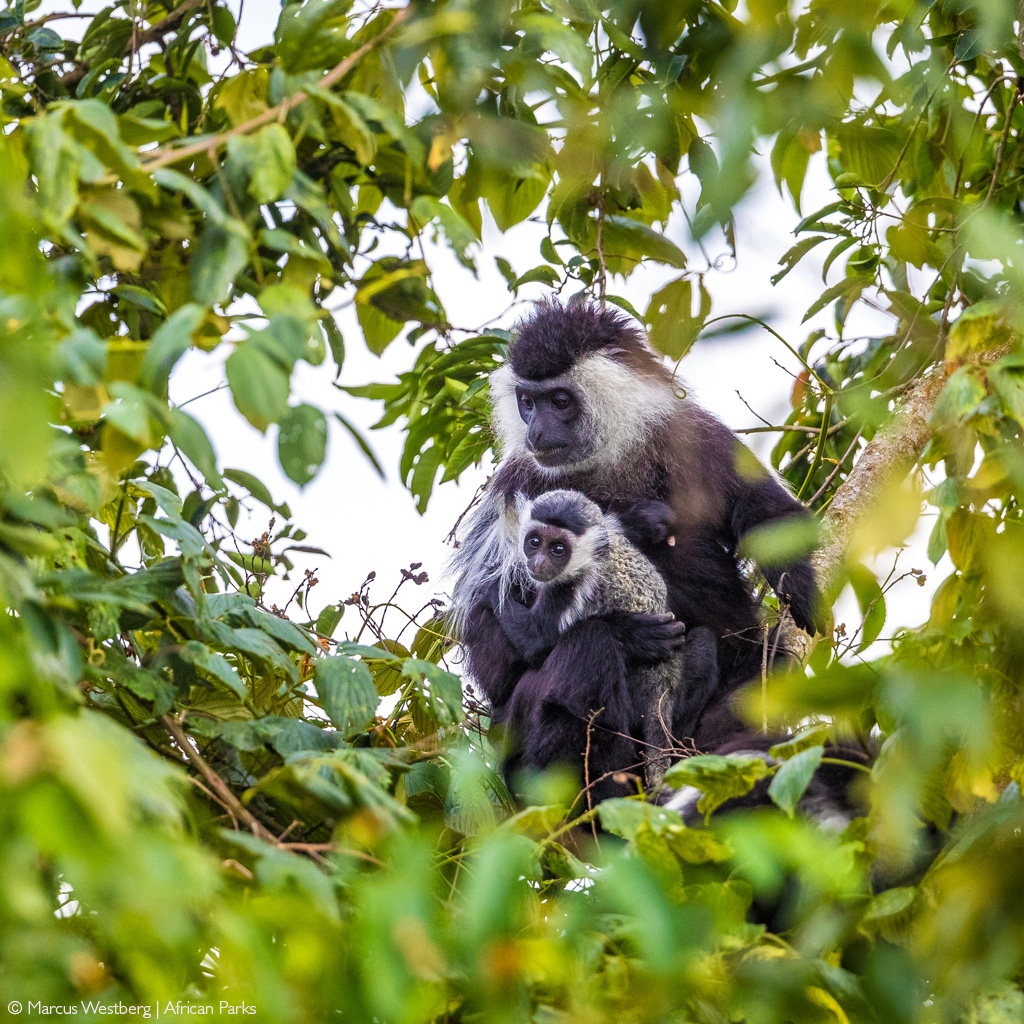
The days are action-packed: lots more trail walking, Rite to Sight and malaria prevention work at the Kitabi Health Centre, and Ross and Claver tackle the 70m-high suspended bridge that adds an incredible aerial experience for visitors to Nyungwe.

Like Akagera National Park, Nyungwe has also embraced Rwanda’s community cooperative ideal and once again, we’re amazed at the many innovative business projects that African Parks has helped develop to generate income for neighbouring communities and stimulate local support for conservation. This includes everything from pig farming to public toilets on the main road through the park, to vehicle recovery teams (when trucks miss a tight turn) and even the construction of the new park HQ. The HQ is being built almost entirely by community cooperatives from handmade mudbricks and pit-sawn timber from nearby exotic tree plantations. Theopiste Mushimire, the dynamic lady overseeing the enormous construction site, tells us that when finished, it will be one of the finest forest conservation facilities in the world.
Jes Gruner (African Parks’ regional manager) and Ross take off on a long trek to overnight at the newly built riverside Cyinzobe Camp with its wooden A-frame huts. “It’s the most beautiful forest trail and rustic camp I’ve ever experienced,” Ross says later. “We could hear the sounds of the Kamiranzovu Waterfall all night and all around us, 360° of pristine rainforest and mountains.”
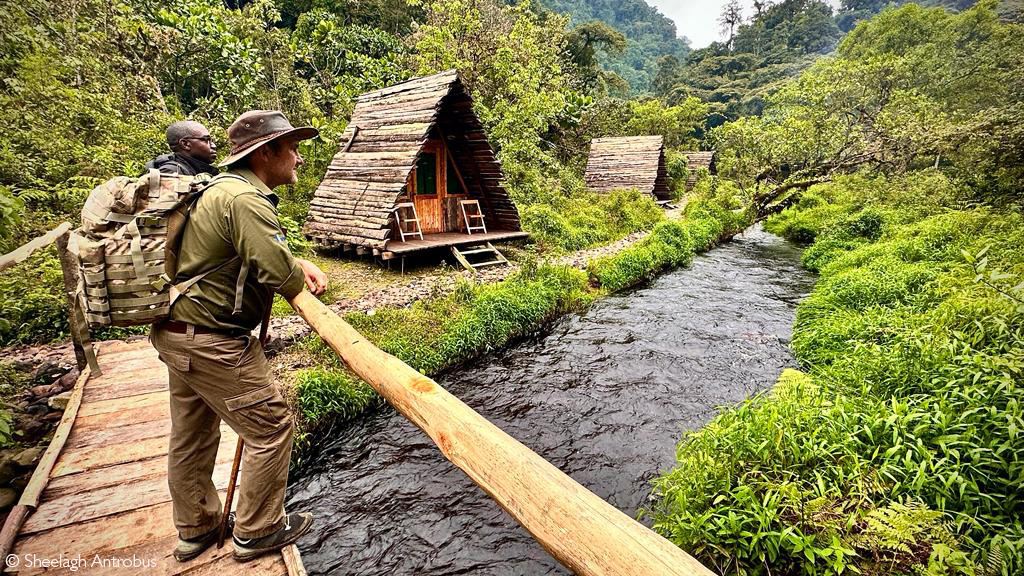

The surrounding tea plantations are wet, shiny green as we follow bouncy Pierre Ntimemuka (whose surname means ‘God never disappoints’), dodging puddles and running through the rain to the Gisakura School hall, where children have gathered for the judging ceremony of the Wildlife Art competition. With 16 years of experience at Nyungwe, Pierre is the community liaison manager and tells us that one of the critical components of Nyungwe’s community engagement is working with local schools through environmental clubs.
These Wildlife Art competitions form an exciting part of this Afrika Odyssey expedition, but this is different. Instead of the ordinary elephant and rhino on the templates, today is the first time that the art subject is a large chimpanzee, around which the young artists have drawn rainforests, mountains, waterfalls, colobus monkeys and birds like the great blue turaco. The best artists each get a turn with the expedition’s talking stick and read out their messages, like: ‘Conservation is the future, and young people must take responsibility’; ‘Protect these forests – they bring tourism, development, clean air and water for all’; and ‘My message to all is: stand together, stop illegal activities like mining, poaching and tree-cutting – protect our beautiful forest heritage.’
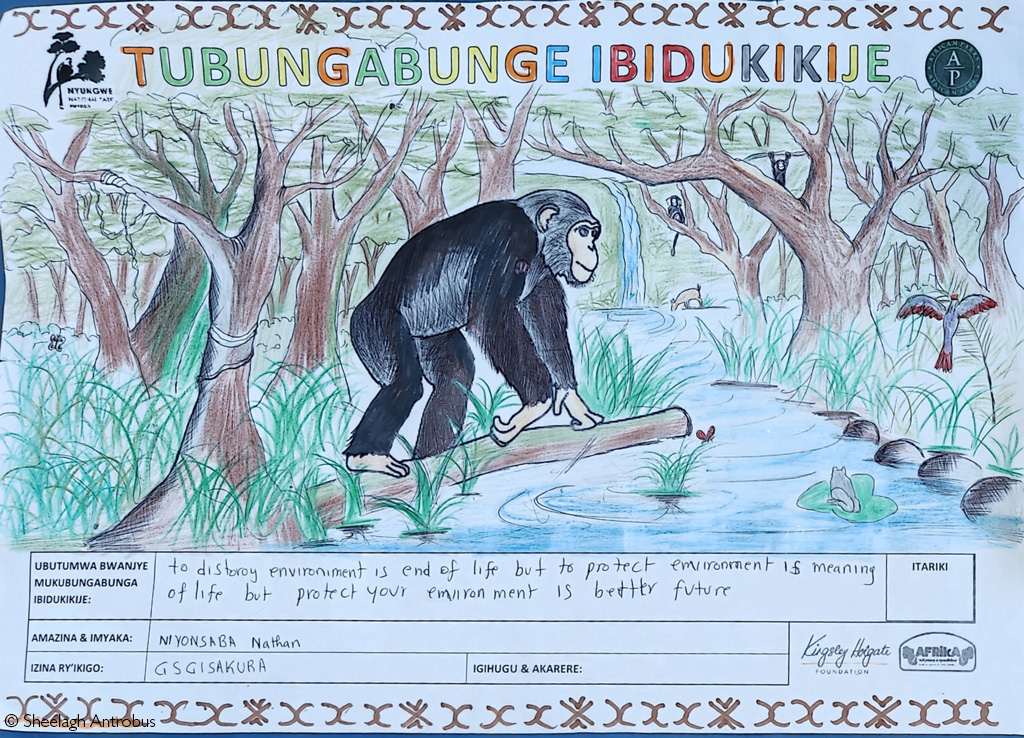
There’s a hushed silence – who will be the ultimate winner? The hall erupts with cheers as Nathan Niyonsaba is called forward –the hot favourite. Nathan then presents Kingsley with a framed portrait of his bearded self on behalf of the school. Unbeknownst to us, the school had found a picture of the ‘Wise Man’, and Nathan had spent days creating the lifelike drawing – it’s a big surprise and adds conviviality to the event!
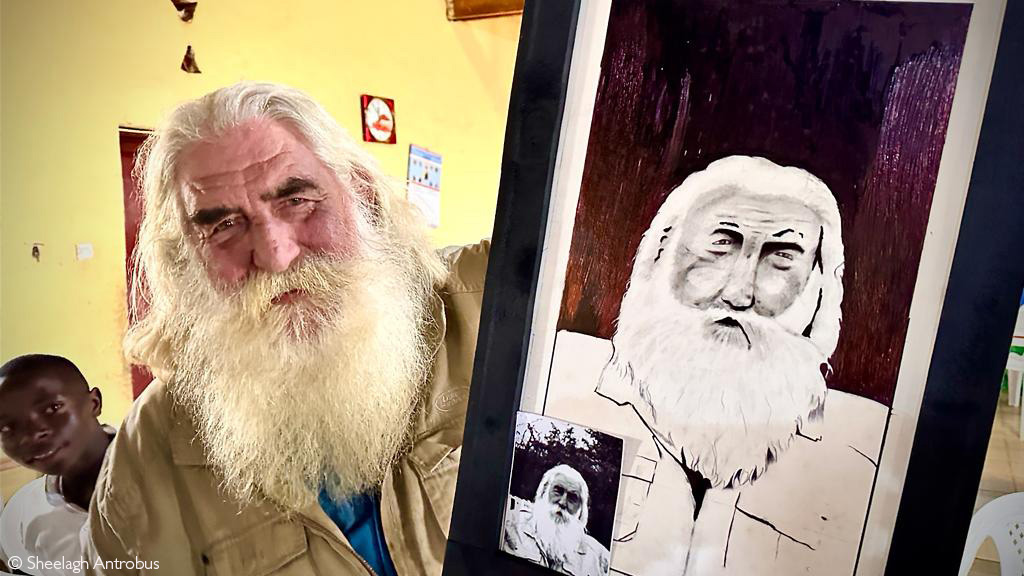
Then comes the adventure of getting to the highest and furthest source of the Nile. It’s one of the most picturesque 4×4 tracks in Rwanda that seems to climb forever into the sky, through remote villages, terraced hillsides, potato fields, tea plantations and belts of exotic trees – we’re told they were planted decades ago to protect the Nyungwe rainforests. It’s a race against time – the light is starting to fade. We reach a summit hillside in the far north of the park, leave the Defenders and enter the forest on foot.
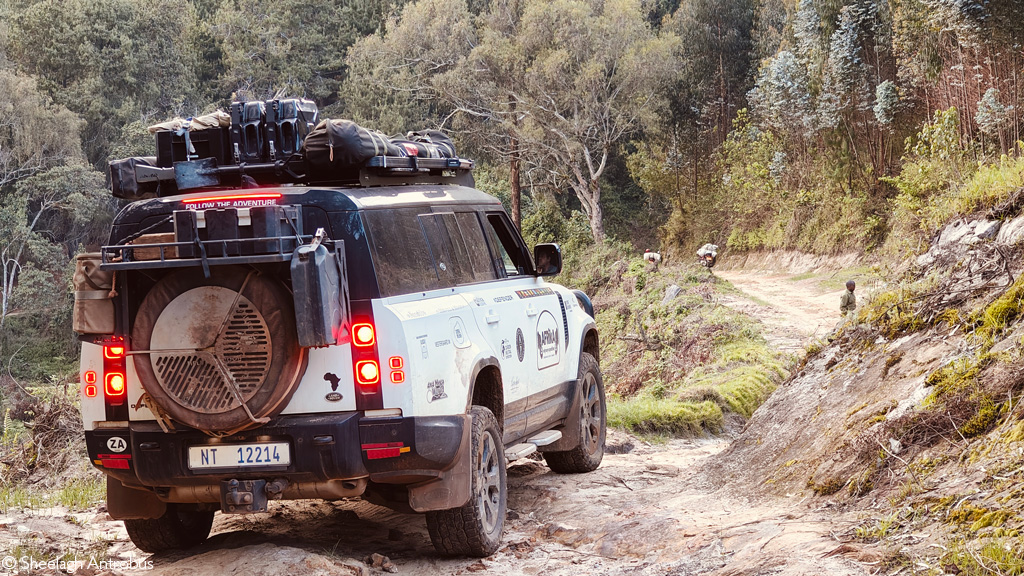
A snake slithers across the trail; park manager Protais jumps back. There’s loads of humour between us and the African Parks team of Protais, Jes, Kambogo, and Pierre.
Finally, we reach it – a small, spongey spring, the trickle of water funnelled into a little pool by a single, broad, green leaf… we’ve reached the furthest source of the White Nile!

A board reads ‘Distance from Egypt – 6,719km’, with the date 2006 and three names: Neil McGregor, Cam McLeay and Garth McIntyre. Kambogo explains that these were the three members of the Ascend the Nile Expedition, who traced the full journey of the Nile from its Mediterranean mouth to this very point and, using GPS, proved beyond doubt that this is the furthest – and highest – source of the White Nile.
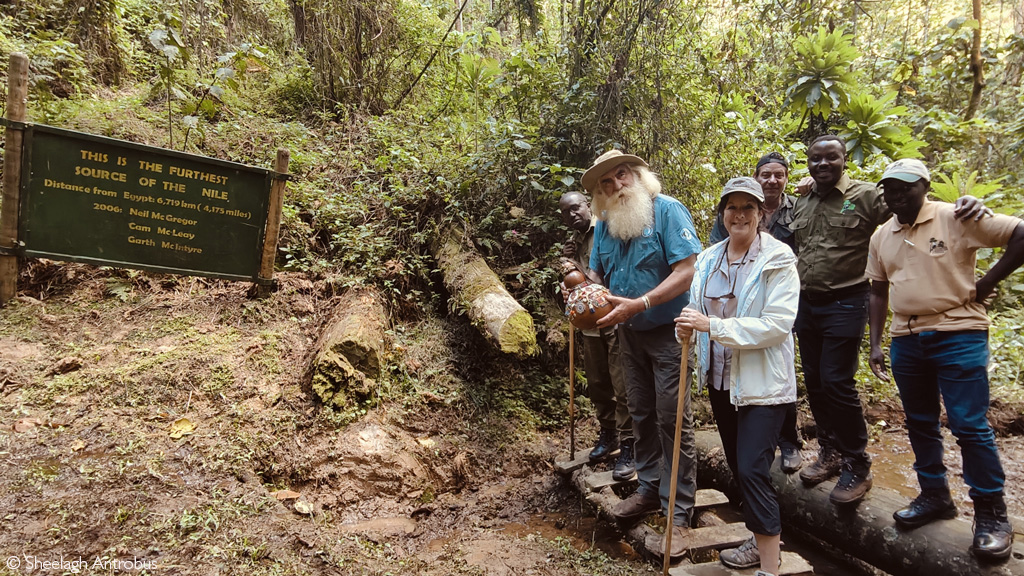
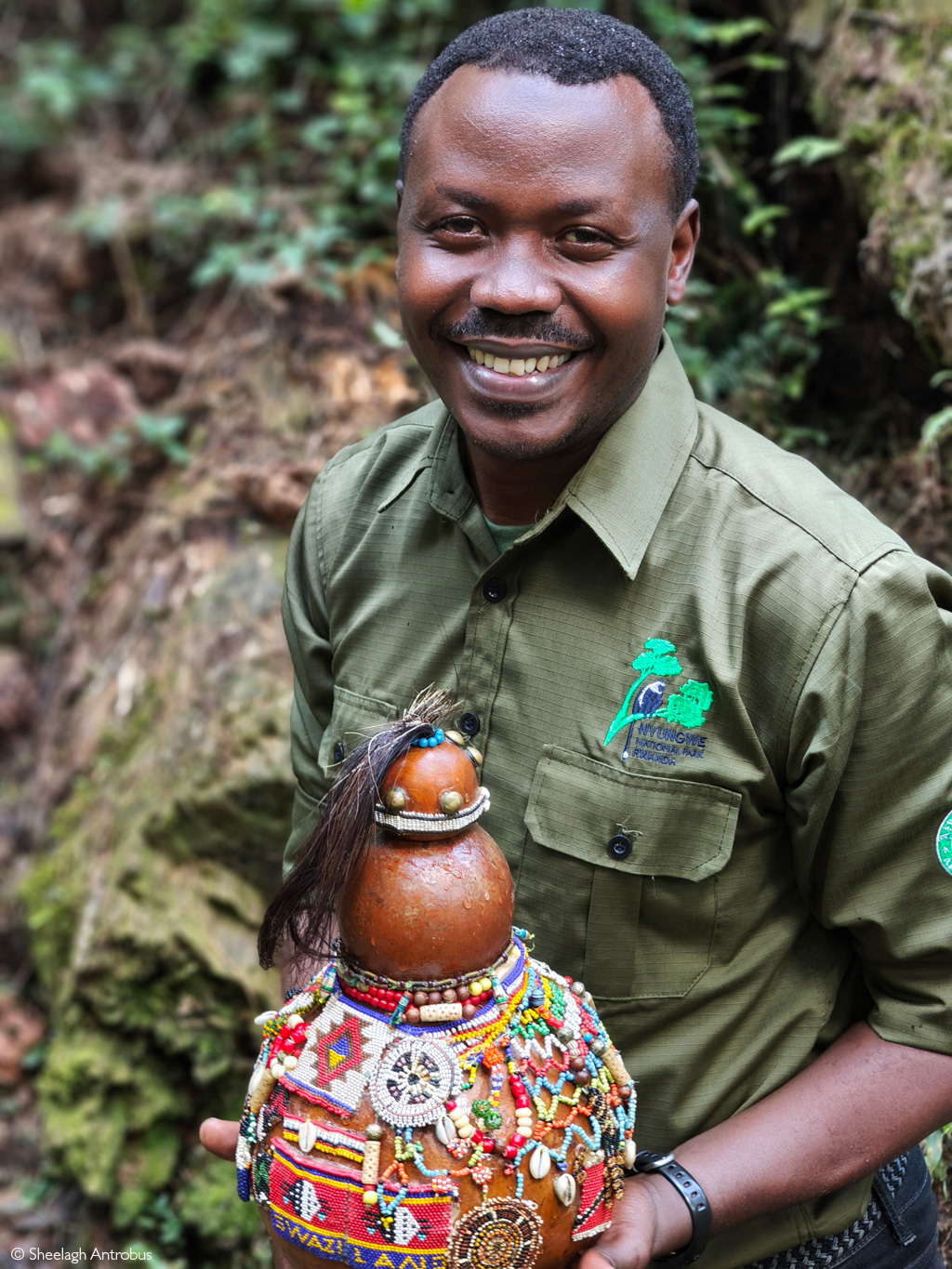
Protais is given the job of adding symbolic water to the calabash. He gives a broad grin as his boots fill with water, and he sinks into the soft mud—everybody roars with laughter.

As we leave Nyungwe, winding through countless hairpin bends, heading north towards the next expedition objective of Garamba NP in the DRC, our lasting memories of this pristine green jewel are its custodians—the extraordinary individuals, each with an inspiring story to tell, who are so committed to preserving this ancient, magnificent rainforest for future generations. Nyungwe is in good hands, and we’re privileged to have been embraced by it.
Further reading
Nyungwe National Park is one of Rwanda’s best kept secrets – a magical tract of montane forest bursting with extraordinary biodiversity. Read more about Nyungwe here.
To comment on this story: Login (or sign up) to our app here - it's a troll-free safe place 🙂.![]()




